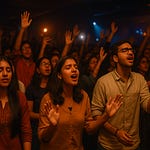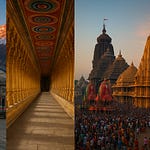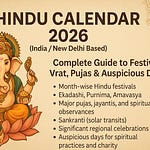Jagannath Puri, located in the eastern state of Odisha, is not just a city—it's a spiritual phenomenon. One of the sacred Char Dham pilgrimage sites (alongside Badrinath, Dwarka, and Rameswaram), Puri is revered as the eternal abode of Lord Jagannath, the Lord of the Universe. With its deep-rooted history, unique rituals, mystical traditions, and unmatched spiritual energy, Jagannath Puri remains the heartbeat of Hindu devotion.
🌟 Origin & History
The origins of Jagannath Puri date back thousands of years and are intricately woven into legends and Puranic stories.
Mythological Origin: According to Skanda Purana, Brahma Purana, and other scriptures, Lord Jagannath manifested in the sacred Nilachala hills. The idol is believed to be self-manifested (Swayambhu) and was later consecrated by Lord Vishnu himself.
King Indradyumna: The temple's most well-known origin tale involves King Indradyumna of the Malwa region, who was guided by divine visions to build a temple for Lord Vishnu in Puri. With the help of divine craftsmen like Vishwakarma (in disguise), the sacred wooden idols of Jagannath, Balabhadra, and Subhadra were created.
Historical Architecture: The current temple was constructed in the 12th century by King Anantavarman Chodaganga Deva, a ruler of the Eastern Ganga dynasty.
🛕 Architecture & Design
The Jagannath Temple is a masterpiece of Kalinga architecture and spans over 400,000 square feet, enclosed by two massive walls:
Meghanada Pacheri (outer wall)
Kurma Bedha (inner wall)
Key Structures:
Vimana (Shikhara): The towering spire housing the sanctum.
Jagamohan (Audience Hall), Nata Mandir (Dance Hall), and Bhoga Mandap (Hall of Offerings).
Unique Features:
The Sudarsana Chakra atop the temple always appears facing you, no matter where you stand.
The temple flag defies wind logic—it always flutters in the opposite direction of the breeze.
Shadowless Temple: The temple casts no shadow at any point of the day, a mystery unexplained by modern science.
🙏 The Deities & Rituals
The three principal deities are:
Jagannath (a form of Krishna/Vishnu)
Balabhadra (Balarama, Krishna’s elder brother)
Subhadra (their sister)
Made from Neem wood, the idols are not made of stone or metal, making them unique in Hindu worship. These are replaced every 12 to 19 years during Nabakalebara, where new idols are ritually created and the souls transferred.
🕯️ Puja, Aarti & Temple Timings
Temple opens: Around 5:00 AM
Mangala Aarti: 5:30 AM
Sakala Dhupa (Morning Offering): 7:00 AM to 8:30 AM
Madhyanna Dhupa (Midday Offering): 11:00 AM to 1:00 PM
Sandhya Dhupa (Evening Rituals): 7:00 PM to 8:00 PM
Badasinghara Bhoga & Pahuda (Final Rituals): 10:30 PM
More than 56 types of bhoga (Mahaprasad) are offered daily, and this Mahaprasad is considered sacred beyond comparison.
🌌 Spiritual Essence & Faith
Jagannath is not just a god, He is Bhakta Vatsala—the Lord who loves His devotees. Puri represents the accessibility of divinity: Jagannath is without boundaries, without limbs, and still all-encompassing.
The Rath Yatra (Chariot Festival) symbolizes the idea that God comes to the people.
Faith here is more than ritual—it's emotion, surrender, and connection.
Every devotee—regardless of caste, creed, or gender—is welcomed in this ocean of bhakti.
🧭 Pilgrimage (Tirth) & Travel
📍 How to Reach:
By Air: Nearest Airport is Biju Patnaik International Airport, Bhubaneswar (60 km).
By Train: Puri Railway Station is well-connected to major Indian cities.
By Road: Connected via NH-316 and NH-203.
🚶 Local Transport:
Rickshaws, auto-rickshaws, and cabs are available easily.
🗓️ Best Time to Visit
Winter (Oct to Feb): Ideal weather for darshan and sightseeing.
Monsoon (June to Sep): Blessed rains and vibrant green landscapes.
Avoid visiting during summer (March to May) as temperatures can soar above 40°C.
🎉 Major Festivals at Jagannath Puri
1. Rath Yatra (June/July) 🌈
The grandest celebration where Jagannath, Balabhadra, and Subhadra are taken out in massive chariots.
Millions of devotees gather to pull the chariots—a deeply symbolic act of devotion.
2. Snana Yatra: Annual bathing festival of the deities.
3. Nabakalebara: Occurs once every 12–19 years when new idols are created.
4. Chandan Yatra, Niladri Bije, Kartik Purnima, and more.
🍛 Mahaprasad – Food of the Divine
The Mahaprasad of Jagannath Temple is cooked in clay pots over wood fire, using no tasting, no onions, no garlic—yet the taste is divine.
Ananda Bazaar is the world's largest open-air sacred food market.
Once offered, this food becomes Mahaprasad, shared by all with devotion.
🔮 Mysteries of Jagannath Temple
No birds fly over the temple.
The sea's sound disappears near the temple steps (Singhadwara).
The temple’s cooking system can prepare food for 100,000 people daily without waste or shortage.
🧘 Devotion, Faith & Experience
The experience of visiting Puri isn’t just about darshan. It's a soul-touching journey—walking barefoot on the hot sands, seeing the Sudarshan Chakra, and feeling the energy of thousands chanting "Jai Jagannath!"
Pilgrims have reported emotional awakenings, miraculous healings, and spiritual elevation after their visit.
Jagannath Puri is not just a temple; it's a living, breathing manifestation of Hindu faith and mysticism. It merges the spiritual, cultural, and divine into a timeless tirtha where the Lord of the Universe resides—not on a golden throne, but in the hearts of millions.
If Varanasi is moksha, and Rameswaram is cleansing, Jagannath Puri is surrender.
A place where God steps out to meet you.










